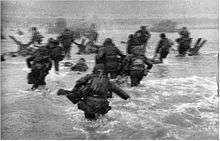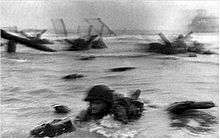The Magnificent Eleven



The Magnificent Eleven are a group of photos of D-Day taken by Robert Capa. Capa was with the second wave of troops landing on the American invasion beach, Omaha Beach, who faced heavy resistance from German troops in their bunkers within the Atlantic Wall. While under constant fire Capa took 106 pictures, all but eleven of which were destroyed in a processing accident in the Life magazine photo lab in London. The surviving photos have since been called the Magnificent Eleven. Steven Spielberg is said to have been inspired by these images when filming Saving Private Ryan.[1]
Taking the pictures
Capa came ashore with the men of the 16th Infantry Regiment of the 1st Infantry Division on 6 June 1944 (D-Day) in the second assault wave on Omaha Beach. He used two Contax II cameras mounted with 50 mm lenses and several rolls of spare film, and took 106 pictures in the first two hours of the invasion. Capa returned with the unprocessed films to London, where a staff member at Life made a mistake in the darkroom; he set the dryer too high and melted the emulsion in the negatives in three complete rolls and over half of a fourth roll. Only eleven frames in total were recovered.[2][3] Capa never said a word to the London bureau chief about the loss of three and a half rolls of his D-Day landing film.
Although a fifteen-year-old lab assistant named Dennis Banks was responsible for the accident, another account, now largely accepted as untrue, blamed Larry Burrows, who worked in the lab not as a technician but as a "tea-boy".[4]
Capa's former editor, John G Morris, has disputed the existence of the so-called lost pictures in an interview with CNN's Christiane Amanpour, which was reported on 12 November 2014. "It now seems that maybe there was nothing on the other three rolls to begin with. Experts recently have said you can't melt the emulsion off films like that and he just never shot them," Morris said. "So I now believe that it's quite possible that Bob just bundled all his 35 together and just shipped it off back to London, knowing that on one of those rolls there would be the pictures he actually shot that morning."[5]
Photo controversy
For many years the soldier in the most well-known of the photographs was identified as Edward Regan, but recently the daughter of Alphonse Joseph Arsenault has claimed that he is the GI. Another soldier, Huston Riley, has been put forward by historian Lowell Getz.[6] Riley himself actually remembers meeting a photographer that helped him out of the water. "I was surprised to see him there. I saw the press badge and I thought, 'What the hell is he doing here?'" he said. "He helped me out of the water and then he took off down the beach for some more photos."[7]
Publication
Life magazine printed some of the frames in its June 19, 1944 issue, "BEACHHEADS OF NORMANDY: The Fateful Battle for Europe is Joined by Sea and Air.".[1] Some of the images had captions that described the footage as "slightly out of focus", explaining that Capa's hands were shaking in the excitement of the moment (something that he denied).[3] It should be noted that earlier in this account, Capa stated that his "empty camera trembled in my hands."[8] This prevented him, however, from loading a new roll of film, not from taking clear shots of the battle.[3] Capa used this phrase as the title of his autobiographical account of the war, Slightly Out of Focus.
Robert Capa
Robert Capa (born Endre Ernő Friedmann, October 22, 1913 – May 25, 1954) was a Hungarian combat photographer and photojournalist who before World War II covered the Spanish Civil War and the Second Sino-Japanese War.
Bibliography
- Notes
- References
- BetterPhoto.com (April 15, 2003). "Photo Trivia of the Week". The Weekly Newsletter of A Better Photo website. Retrieved March 14, 2012.
- Capa, Robert (2001). Slightly out of focus (2001 ed.). Modern Library. ISBN 9780375753961. - Total pages: 236
- Mar, Rebecca (November 24, 2008). "The soldier in the surf". Mercer Island Reporter. Retrieved March 14, 2012.
- Lucas, Dean (February 13, 2010). "D-day soldier in the water". Famous Pictures. Retrieved March 14, 2012.
- Morris, John Godfrey (1998). "The Magnificent Eleven: The D-Day Photographs of Robert Capa". Retrieved March 14, 2012.
- Morris, John G. (June 5, 2004). "D-Day / 60 YEARS LATER: 'This is it:' how Robert Capa got the pictures". New York Times. Retrieved March 14, 2012.